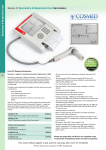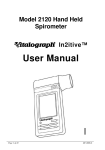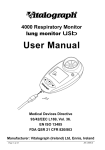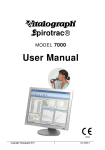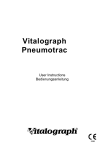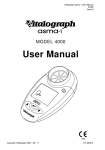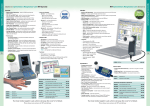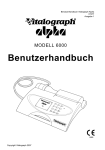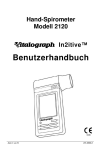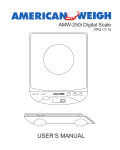Download VUS08508-2 BreathCO Manual for Printing.indd
Transcript
TECHNICAL SPECIFICATIONS Dimensions: Weight: Operating Temperature: Storage Temperature: Humidity: Digital Display: Battery: Display Range: LinearRange: Resolution: 7.1” x 3.9” x 1.75” 10 oz. 32° F to 104° F 23° F to 113° F 0 to 99% 3.5 Digit 1/2” Liquid Crystal Display Standard 9V Alkaline (Type PP3, MN 1604, 6F 22) 0 to 199 ppm 0 to 99 ppm 1 ppm TYPICAL BATTERY LIFE 9V Alkaline Type 250 - 500 Hours ACCESSORIES 29504 Vitalograph BreathCO Calibration Gas Kit 29506 CO Calibration Gas Cylinder (50 ppm) 20202 Monitor Mouthpieces, single patient use (pack of 200) 29512 Sampling-T Connector set (pack of 10) VUS0216 Sampling-T Connector set (pack of 2) REFERENCES Jarvis M.J. et al, “Low Cost Carbon Monoxide Monitors in Smoking Assessment,” Thorax 1986; 41:886-887. VUS08508-2 ® Copyright 2011 Vitalograph Inc. 13310 W. 99th St. Lenexa, Kansas 66215 1-800-255-6626 www.vitalograph.com b Carbon Monoxide Monitor Smoking Cessation Motivational Tool USER MANUAL Vitalograph INTRODUCTION CALIBRATION The Vitalograph BreathCO Monitor is a pocket-sized instrument which can be used to measure both alveolar concentrations and environmental levels of carbon monoxide. This display indicates parts per million (ppm) of carbon monoxide. The Vitalograph-BreathCO is re-calibrated by exposing it to a gas of known concentration. (BreathCO Calibration Kit Cat. No. 29.504). This is usually 50 ppm CO. It is considered to be the single most effective motivational tool in smoking intervention. Equally importantly, weekly follow-up after smoking cessation will detect and therefore deter relapse. CALIBRATE ONLY IN A WELL VENTILATED ENVIRONMENT. 1. Turn BreathCO on, allow display to stablize, then adjust to 0 if needed. HOW TO OPERATE 1. Firmly mount the Sampling-T in the taper on top of the case. 2. Switch the instrument ON using the switch located on the end, nearest the display. The LCD at the top of the monitor will read a high number, which will rapidly fall. 3. A new mini-mouthpiece should be fitted to the Sampling-T for each new user. 4. The unit should be allowed to “warm up” until the display shows 000 ±. If this is not achieved within two or three minutes please refer to the “Display re-zeroing “ section. 5. The subject should take in a deep breath, hold it for 10 seconds and then breath out slowly through the mouthpiece over a period of 20 seconds or more. 6. Record the highest reading indicated on the display after completing the blow. NOTE: ENVIRONMENTAL MONITORING Environmental carbon monoxide levels may be monitored by removing the Sampling-T, switching the unit ON and recording the highest display level. DISPLAY RE-ZEROING Changes in the ambient operating temperature or CO level can cause small drifts in the instrument zero. If adjustment is necessary, slowly move the small slider control, adjacent to the liquid crystal display window, until the display shows all zeros. If the instrument will not zero, possible causes are high ambient levels of CO, faulty calibration or equipment malfunction. To eliminate the possibility of the high ambient level, the unit should be removed to another location and zeroing attempted again. 2. Connect the gas to the Sampling-T. 3. Let the gas flow slowly (approx. 0.5 ltr/min) through the Sampling-T into the instrument. When using the Vitalograph Calibration Kit the regulator should be set to 5 psi. 4. Once the displayed value stops increasing, it should be within ± 5% of the gas concentration. (i.e. 48-52) . 5. If the instrument does not display a reading within the specifications, slowly adjust the “SPAN” recessed adjustment screw on the rear of the instrument, until the display reads 50. (Be careful or you could damage it). If this cannot be achieved, the electrochemical sensor in the product must be replaced. Please contact our technical support department if this should occur. 6. After calibration, disconnect the Sampling -T and allow the instrument to settle for 5 minutes. Recheck the instrument zero. Re-adjust the zero if necessary, as detailed in the previous section. GENERAL MAINTENANCE A General maintenance and calibration should be performed on an annual basis. A calibration check should be performed as required. The Sampling-T should be changed after approximately 50 tests have been performed. When replacing the battery be sure to use only alkaline batteries. 1. Press down on panel marked ‘OPEN’ and slide cover in direction of arrow. Then gently lift cover from the instrument. 2. Remove and discard the old battery. 3. Replace with a new battery of the correct type. 4. Ensure that the connector is fitted correctly. 5. Ensure the leads are tucked nearly away, before replacing battery compartment cover.


